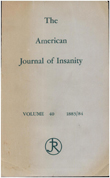Who comes to a voluntary depression screening program?
Abstract
OBJECTIVE: The purpose of this study was to describe who comes to a voluntary depression screening program by analyzing findings from the 1992 National Depression Screening Day. METHOD: Survey results from 5,367 adult volunteers at 345 facilities were analyzed. The authors examined the prevalence of depression detected at the screening test and sociodemographic characteristics and treatment history of the respondents. They also estimated the percentage of these individuals who would actually have a diagnosis of major depression (positive predictive value). The main assessment measure was the Zung Self-Rating Depression Scale. RESULTS: Of all participants, 76.6% (N = 4,109) had at least minimal depressive symptoms (score of at least 50 on the Zung depression scale), 53.3% (N = 2,859) had at least moderate symptoms (score of at least 60), and 22.6% (N = 1,214) had severe symptoms (score of at least 70). Few of the depressed respondents were currently in treatment for a mental health problem. The positive predictive value of a screening test diagnosis of depression was between 92.5% and 95.5% when a cutoff score of 60 was used to indicate depression and between 88.7% and 92.3% when a cutoff score of 50 was used. CONCLUSIONS: Voluntary screening tests, as exemplified by results from the National Depression Screening Day, provide a good opportunity for identifying previously unidentified and untreated individuals with depression.
Access content
To read the fulltext, please use one of the options below to sign in or purchase access.- Personal login
- Institutional Login
- Sign in via OpenAthens
- Register for access
-
Please login/register if you wish to pair your device and check access availability.
Not a subscriber?
PsychiatryOnline subscription options offer access to the DSM-5 library, books, journals, CME, and patient resources. This all-in-one virtual library provides psychiatrists and mental health professionals with key resources for diagnosis, treatment, research, and professional development.
Need more help? PsychiatryOnline Customer Service may be reached by emailing [email protected] or by calling 800-368-5777 (in the U.S.) or 703-907-7322 (outside the U.S.).



